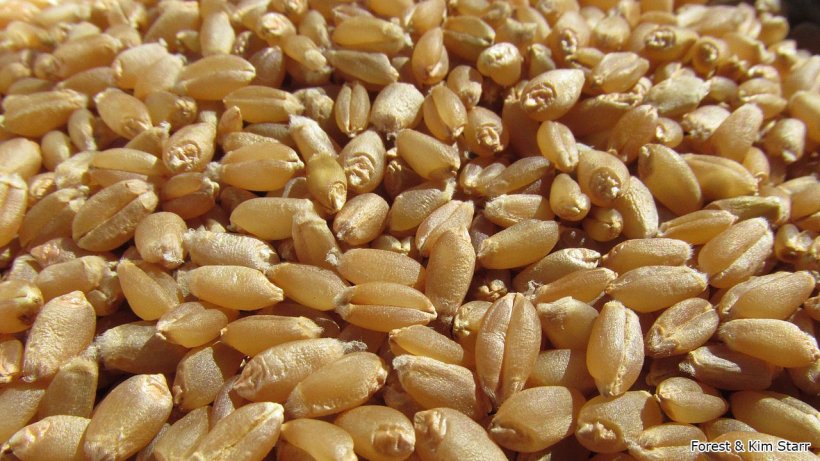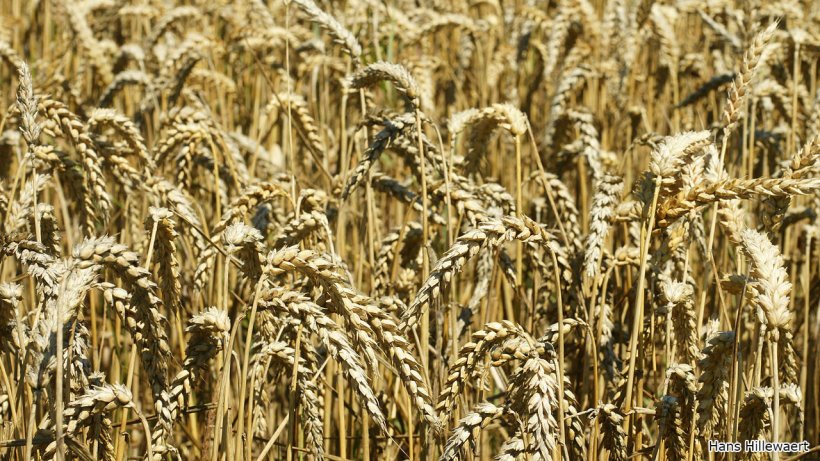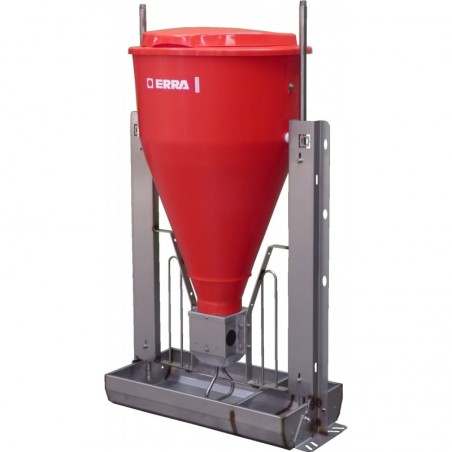Introduction
Bread wheat or common wheat (Triticum aestivum), a member of the Gramineae family, is a hexaploid monocot herbaceous plant grown throughout the world, the main growing zone being the temperate areas of the northern hemisphere. Because common wheat is the variety most used in bakery, it is the most widely grown. It is available and commonly used for animal feeding, sometimes mixed with Durum wheat (Triticum durum), the tetraploid variety cultivated for the pasta and semolina industry. This mix allows variability in the fiber, protein, and energy content.


Common wheat is composed of approximately 2.5 % germ, 15% bran (pericarp and testa), and 82.5 % endosperm (including the aleurone). Wheat constitutes one of the main energy sources in swine diets because it contains approximately 59.5 % starch and is more protein rich (10 - 12 %) than other cereals such as corn (7.5 - 8 %) or barley (9.5 - 11 %) allowing it to replace corn in high energy diets and reduce the need to include protein sources (the typical situation in piglet diets). Wheat however, has a lower energy value than corn (ME/kg) due to its similar fiber content, but low lipid content (2 %). Although less relevant to the swine industry than to poultry, the presence of pentosans (4 - 5-%, including arabinoxylans), which are carbohydrate chains that increase the viscosity of the digesta, can present a problem especially in young animals. Common wheat is relatively poor in lysine (around 2.9 % of the protein) but due to its high protein content, the total contribution of lysine and other amino acids is greater than other typical high energy cereals like corn. Like other cereals commonly used in swine diets, common wheat is poor in minerals and vitamins. Finally, common wheat possesses a non-negligible endogenic phytase activity when used as meal, but it should be noted that this is neutralized in the pelleting process. The common wheat, that has been improved basically on its starch and gluten content (10 % of glutenins in the gluten component) to optimize the bakery processes, provides the rheological characteristics of plasticity and compactability that makes it ideal to improve the quality of the pellet and the efficiency of the pelleting process.
Production and Trade
Graphics showing overall wheat production and trade data
Production
Trade


Comparative Study of Nutritional Values
The systems used in the comparison are: FEDNA (Spain), CVB (Holland), INRA (France), NRC (United States), and Brasil.

| FEDNA1 | CVB | INRA | NRC | Brasil | |
| DM (%) | 88.7 - 89.7 | 85.8 | 86.8 | 86.38 | 87.5 |
| Energy value (kcal/kg) | |||||
| Crude protein (%) | 10.2 - 12.9 | 11.2 | 10.5 | 10.92 | 11.5 |
| Ether extract (%) | 1.4 - 1.6 | 1.4 | 1.5 | 1.4 | 1.6 |
| Crude fiber (%) | 2.3 - 2.4 | 2.3 | 2.2 | - | 2.4 |
| Starch (%) | 58.4 - 60.6 | 58.9 - 60.3 | 60.5 | 60.0 | 56.7 |
| Sugars (%) | 1.5 | 2.7 | 2.4 | - | - |
| DE growing pigs | 3475 - 3570 | - | 3310 | 3450 | 3340 |
| ME growing pigs | 3390 - 3470 | - | 3210 | 3376 | 3243 |
| NE growing pigs | 2485 - 2500 | 2521 | 2510 | 2595 | 2498 |
| NE sows | 2500 - 2540 | 2521 | 2540 | 2595 | 2556 |
| Protein value | |||||
| Digestibility of crude protein (%) | 86 - 87 | 81 | 84 | - | 86.4 |
| Composition of amino acids (% CP) | |||||
| Lys | 2.72 - 2.82 | 3.10 | 3.10 | 3.21 | 3.03 |
| Met | 1.55 - 1.61 | 1.80 | 1.70 | 2.01 | 1.75 |
| Met + Cys | 3.80 - 3.91 | 4.30 | 4.20 | 2.84 | 4.11 |
| Thr | 2.85 - 2.91 | 3.20 | 3.20 | 3.21 | 3.16 |
| Trp | 1.10 - 1.13 | 1.30 | 1.30 | 1.28 | 1.33 |
| Ile | 3.50 - 3.64 | 3.80 | 3.80 | 3.11 | 3.80 |
| Val | 4.25 - 4.36 | 4.80 | 4.70 | 4.30 | 4.65 |
| Arg | 4.55 - 4.83 | 5.30 | 5.30 | 4.76 | 5.13 |
| Standardized ileal digestibility (% CP) | |||||
| Lys | 84 | 84 | 81 | 82 | 82.2 |
| Met | 90 | 90 | 89 | 90 | 89.8 |
| Met + Cys | 89 | 90 | 90 | 90 | 90.5 |
| Thr | 85 | 86 | 83 | 85 | 82.6 |
| Trp | 88 | 88 | 88 | 88 | 87 |
| Ile | 90 | 90 | 89 | 90 | 88.8 |
| Val | 87 | 88 | 86 | 87 | 86.7 |
| Arg | 89 | 90 | 88 | 89 | 87.6 |
| Minerals (%) | |||||
| Ca | 0.04 - 0.05 | 0.04 | 0.07 | 0.03 | 0.06 |
| P | 0.29 - 0.30 | 0.28 | 0.32 | 0.3 | 0.32 |
| Phytate P | 0.19 - 0.20 | 0.18 | 0.14 | 0.2 | 0.22 |
| Available P | 0.15 | - | - | - | 0.1 |
| Digestible P | 0.1 | 0.08 | 0.1 | 0.17(*) | 0.16(*) |
| Na | 0.02 | 0.01 | 0.01 | 0.01 | 0.01 |
| Cl | 0.08 - 0.09 | 0.05 | 0.09 | 0.08 | 0.08 |
| K | 0.32 - 0.40 | 0.38 | 0.40 | 0.46 | 0.39 |
| Mg | 0.11 - 0.14 | 0.09 | 0.10 | 0.11 | 0.1 |
1 The FEDNA evaluation system gives the range of values (minimum and maximum) derived from integrating the 4 classifications that the evaluation system considers, based principally in the protein and moisture content (National Common Wheat with CP contents of 10.2%, 11.2% and 12.9% and English Common Wheat, to represent wheat imports from areas with growing conditions similar to the United Kingdom and French Brittany).
(*) Values subject to meal diets that consider the endogenous phytase activity of wheat. In pelleted diets these values can be reduced by 30-35%.
Unlike the other tables, FEDNA clearly distinguishes between three qualities of common wheat classified according to the protein content and two origins which are essentially differentiated by the moisture content. The rest, CVB, INRA y NRC consider just one quality of common wheat with intermediate values for protein (10.5 - 11.2 %) except BRASIL (11.5%), that places a middle value between that of the middle and high values found by FEDNA. In terms of moisture content, the value determined by FEDNA for European wheat (United Kingdom and French Brittany) is quite similar to the moisture content suggested by CVB, INRA, NRC y BRASIL. There is a slight positive correlation between the dry matter content and protein (r2 = 0.24) and a strong negative correlation (r2 = 0.67) between the protein and starch contents (with the exception of BRASIL which strongly penalizes the starch content).
These relationships directly impact the estimation of net energy (NE) values because the clear positive correlation between the starch content and the NE is evident (with the exception of NRC which estimates a very high NE for intermediate values of starch compared to the rest of the systems where this relationship is more direct and occasionally does not consider fiber).
It should be noted that unlike the rest of the systems, BRASIL gives higher values for protein (11 % greater than the FEDNA value low in protein and high in moisture) and in lipids (13 % greater than the FEDNA value for national wheat although it is equal to the value for United Kingdom wheat), however the fiber content is fairly consistent. The estimated energy values from the distinct systems are similar, with variations smaller than 2.5%, with the exception of NRC which gives a clearly higher value (up to 5.2%). In terms of NE, the internal variation that FEDNA presents due to the segregation on the basis of the protein content is no greater than 0.6%.
In terms of total amino acids, using lysine as a reference, and at the same protein content (11.1 ± 1.3 %), it is observed that all the compared systems give similar values and greater than FEDNA. INRA and CVB present a 10 % increase in the lysine content while BRASIL presents an 8 % increase. In a more extreme case, NRC presents a 13 % greater lysine value. The values for the rest of the total animo acids are fairly proportional to lysine, presenting more variability in sulfur-containing amino acids. The digestibility coefficient of lysine presents a range of 86 - 87 % (BRASIL and FEDNA), while IRNA finds an intermediate value at 74 % with a lower value than that of CVB.
Recent Research Findings
1. Determination of chemical composition, energy content, and amino acid digestibility in different wheat cultivars fed to growing pigs.
In different wheat cultivars fed to growing pigs significant differences were observed in the DE, ME values, and the ATTD of GE. There were also differences in the AID and SID of CP and indispensable AA. In conclusion, the chemical composition, energy contents, and most AA digestibility in different cultivars of wheat varied widely.
2. Degradation of dietary fiber in the stomach, small intestine, and large intestine of growing pigs fed corn- or wheat-based diets without or with microbial xylanase.
Microbial xylanases may contribute to the degradation of fiber in wheat and wheat-based diets and in corn and corn-based diets along the intestinal tract of pigs. Xylanase “A”supplementation improved the concentration of DE and ME in wheat-SBM-wheat middlings diets and xylanase “B” improved the concentration of DE in wheat-based diets and the concentration of the ME in wheat-SBM diet. Therefore, the xylanases supplementation improves the digestibility of dietary fibre in the stomach and hindgut and the energy status of pigs fed wheat-based diets.
3. Additivity of apparent and standardized ileal digestibility of amino acid determined by chromic oxide and titanium dioxide in mixed diets containing wheat and multiple protein sources fed to growing pigs.
In wheat based diets combined with different protein sources, the most accurate prediction of ileal digestibility of CP and AA was achieved using SID rather than AID in mixed diets containing wheat, CM, MBM, and DDGS. The determination of endogenous loss, AID, and SID of CP and AA were not affected by marker type. In addition, the additivity of AID and SID of CP and most indispensable AA in mixed diets was not affected by marker type.
4. Impact of xylanases on gut microbiota of growing pigs fed corn- or wheat-based diets.
The xylanase supplementations in wheat based diets, reduced the influence of Bacteroidetes and promoted a large number of hub taxa majority of which belonged to the Firmicutes phylum. To maximize the efficiency of xylanase supplementation, it was suggest that xylanase originated from Bacillus subtilis was more effective when applied to wheat-based diets, while xylanase originated from Fusarium verticillioides was more beneficial when applied to corn-based diets.
5. Energy content and nutrient digestibility of diets containing Lactobacillus-fermented barley or wheat fed to weaned pigs.
The energy content and apparent total tract digestibility (ATTD) of nutrients of diets containing Lactobacillus-fermented barley or wheat fed to weaned pigs can be beneficially substituted for unfermented wheat, improving the ATTD of nutrient and energy, nitrogen retention, and energy content. Also, Hetero-inoculum is preferable to Homo-inoculum for grain fermentation considering greater energy content in weaned pigs.
6. Effects of xylanase supplementation to wheat-based diets on growth performance, nutrient digestibility and gut microbes in weanling pigs.
Xylanase supplementation in wheat based diets increased growth performance and nutrient digestibility up to 2,000 U/kg. Moreover, the supplementation of xylanase (2,000 U/kg) decreased the richness of gut bacteria but diminished the growth of harmful pathogenic bacteria, such as Escherichia-Shigella, in the colon along the nursery period.
7. Effect of wheat as a feedstuff in starter diets on nursery pig growth performance and digestibility.
It is hypothesized that what can completely replace corn in weanling diets. Therefore both, performance and digestibility (in terms of N, EE, GE, P, and NDF) results demonstrate that wheat can be fully or partially substituted for corn in nursery diets. Moreover, the addition of carbohydrase enzymes in starter diets improved nutrient digestibility, but resulted in poorer growth performance.
References
Foreing Agricultural Service. USDA. https://apps.fas.usda.gov/psdonline/app/index.html
FEDNA: http://www.fundacionfedna.org/
FND. CVB Feed Table 2016. http://www.cvbdiervoeding.nl
INRA. Sauvant D, Perez, J, y Tran G, 2004, Tables de composition et de valeur nutritive des matières premières destinées aux animaux d'élevage,
NRC 1982. United States-Canadian Tables of Feed Composition: Nutritional Data for United States and Canadian Feeds, Third Revision.
Rostagno, H,S, 2017, Tablas Brasileñas para aves y cerdos, Composición de Alimentos y Requerimientos Nutricionales, 4° Ed






